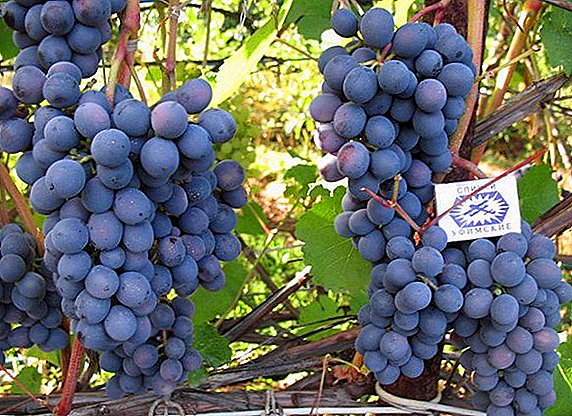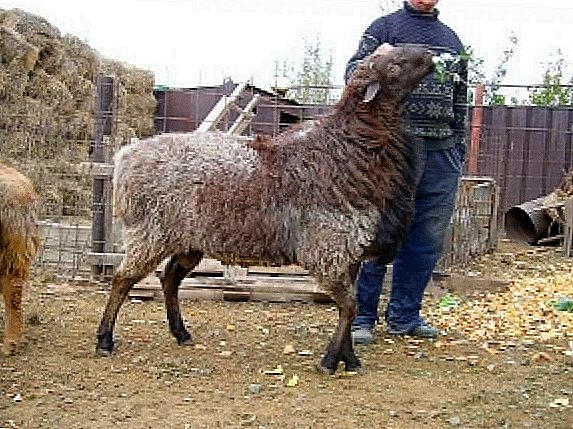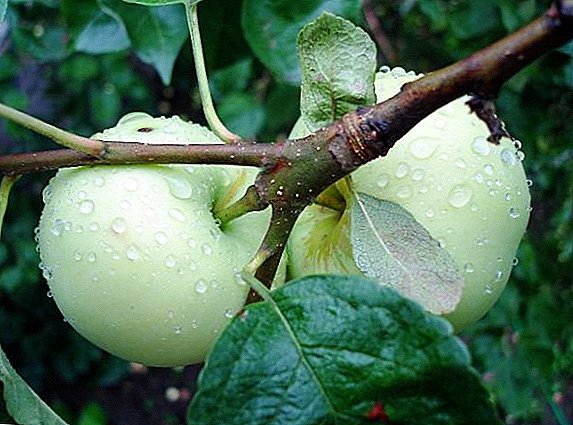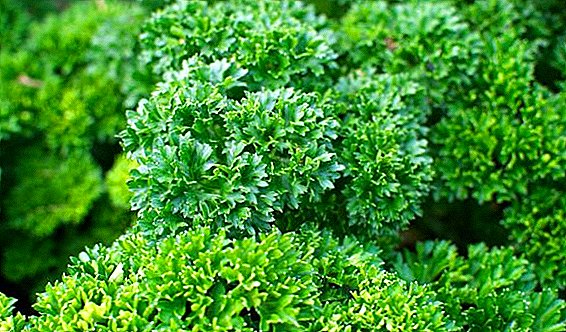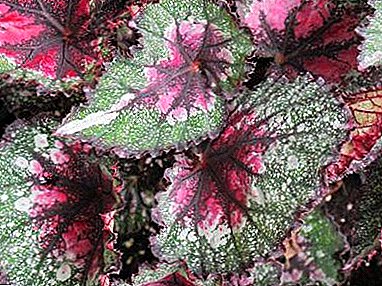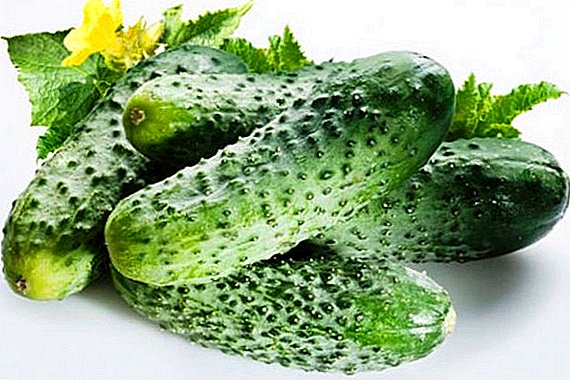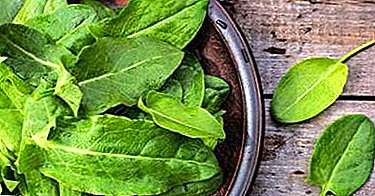
Sorrel - a real storehouse of vitamins. In its leaves in large quantities contain vitamins B, C and K, fiber, iron, phosphorus, potassium, which are vital to the human body. Therefore, it is often grown on the backyards. Unfortunately, sorrel is extremely highly diverse diseases and pests. To grow a healthy plant, you should have an idea of its most frequent diseases and methods of dealing with them.
Plant diseases c photo
Further, it will be considered what kind of pests and diseases sorrel can be affected with, how to deal with them and how to treat them, and the types of plant damage are presented in the photo.
Perinosporosis
Perinosporosis is known as downy mildew, most often infecting the young leaves of sorrel. It is a fungal disease.
With cold and high humidity it progresses more strongly. Carries with raindrops and wind. When peronospora on the leaves formed a gray-purple bloom. They turn pale, start to curl downwards, become brittle and wrinkled. As a result, the affected leaf dies.
Important! The disease persists on dead leaves. Therefore, to get rid of it, they should be collected and burned. When the first signs appear, remove the affected plant.
From chemical means gardeners prefer:
- Previkur;
- Soon;
- Vitaros.
These drugs are applied once. Diluted with water in the proportion shown on the package, most often it is 1:10. In addition, to combat the disease, you must take 2 large spoons of dry mustard and combine with 10 liters of boiled water. Sorrel is sprayed with this solution twice a day for a week. For the prevention of the disease, as well as the fight against it in the initial stages, sorrel must be sprayed with solutions of Bordeaux mixture and copper sulfate.

Rust
Rust, affecting garden plants, there are several types. In the temperate zone, Puccinia acetosae is most common. It manifests itself in the form of blisters of yellow-orange color. Over time, they burst and release spores of bright orange color, which are carriers of the disease. With the same probability can occur on the stems, petioles and leaves of sorrel.
Attention! Adding phosphate-potassium fertilizer significantly reduces the risk of rust.
At the first signs of infection, diseased leaves should be carefully collected in a plastic bag, removed from the site or burned. Every two weeks, seedlings need to be sprayed with a solution of copper sulphate or potassium permanganate. In autumn, the site should be digged and promulcated with humus and sawdust.
Besides, For the treatment of rust, you can use a mixture of 20 grams of soap and 1 gram of copper sulfate. The resulting mixture is diluted in a liter of cooled boiled water. Used twice a day throughout the week. Also, chemicals such as Fitosporin and Plangiz help fight rust. They are used as a solution, diluted in water at a ratio of 1:10.

Gray rot
Like most fungal diseases, it is most active at low temperatures and in wet season. Rot manifests itself in the form of large brown spots, gradually increasing in size. Sorrel foliage softens, becomes loose and watery and quickly rot.
The disease spreads to neighboring bushes at high speed. Therefore, at an early stage of the disease it is very important to remove the affected parts of the plant in time. If the damage is not strong, the seedlings can be sprayed with a solution of wood ash, ground chalk and copper sulphate.
The following fungicides help to fight gray mold well:
- Alirin-B;
- Pseudobacterin-2;
- Fitosporin-M;
- Planriz;
- Trichodermin.
These drugs belong to the category of biofungicides. This means that they contain substances that are safe for the human body, but detrimental to spores and harmful fungi. Used once a week for a month. To create a solution, 4 ml of any preparation is taken and diluted in 10 liters of water. Of the more powerful chemicals most commonly used are Fundazole and Topsin-M. These drugs are diluted in water at a ratio of 1:10.
For the prevention of gray rot, sorrel should be planted in well-lit and ventilated places. Periodic pollination of the soil around the sorrel with ash or lime at the rate of 10-15 g per shrub will be useful. The mulching of the ground with peat helps well.

Spotting
Septoria or white spotted sorrel is a fungal disease. Especially actively developing in conditions of high humidity. It affects the leaves, stalks and stalks of plants. Manifested in the form of light spots with a dark border. In some cases, the spots have a gray-brown color, and the border is yellow. They gradually grow until they occupy the entire surface of the sheet plate. Then the leaf dries and falls, and the stem turns brown and bends. Sorrel immunity is greatly weakened, making it a target for other diseases.
To combat infection, diseased leaves are destroyed. Plants are sprayed with medicinal preparations or fungicides. Especially effective solutions with a copper content - copper sulfate, Bordeaux liquid. After harvesting the land is dug up, fertilizers are applied. These funds are used once in the form of a solution.
Attention! Spraying Bordeaux liquid and copper sulfate will be useful. The concentration of the solution should be lower than that required for the treatment of infection.
For the prevention of septoria, humus and peat should be added to the soil. To get rid of this disease, you can grind a kilogram of red pepper and pour 10 liters of water, after which the product is infused for 2 days. Sorrel is sprayed with this popular recipe once a day, for 7 days.

Mealy dew
One of the most harmful diseases of sorrel. It affects both the stems and leaves of the plant. Manifested in the form of white bloom interspersed with dark points of glutocarpia (fruit bodies of the causative agent fungus).
For the treatment and prevention of infection using traditional and chemical means. From folk remedies, soda solution with household soap helps to cope with powdery mildew. Chemical preparations are as follows:
- Fundazole;
- copper sulphate;
- Topaz;
- colloidal sulfur;
- Byleton
These preparations are diluted with water at a ratio of 1:10, and then spraying sorrel is performed. When using folk remedies, it is necessary to take a tablespoon of soda and a teaspoon of soap, and then dissolve in 4 liters of water. This means the affected plant is sprayed twice a day for 7 days. For the prevention of the development of the disease, sorrel is recommended to spray 2% solution of copper sulfate.

Ovularosis
It is a fungal disease that affects only sorrel. Ovulariasis manifests itself in the form of small, gray-brown with a light center and dark purple border spots. Over time, they increase in size to 10-15 mm and merge. The infected part of the leaf dries and falls. On the lower side of the leaf spots have a brown color. In wet weather, they appear light gray bloom.
To combat the disease, the affected leaves are destroyed. After cutting, it is impossible to plant sorrel again in the same area for at least 4 years. After the affected sorrel is cut, healthy plants are treated with Fitoverm, 4 ml of the preparation per liter of water is taken. One-time processing.

As you can see, diseases that are susceptible to sorrel a lot. And he has more pests. However, if you notice the nascent disease in time and take the right preventive measures, the harvest will be saved and will delight you all the summer season.


